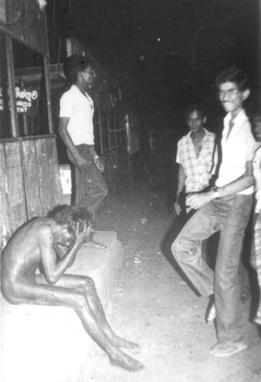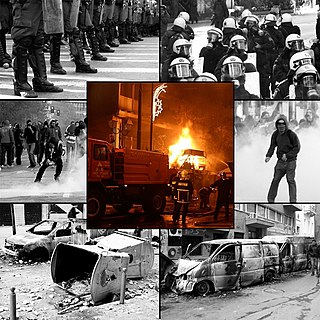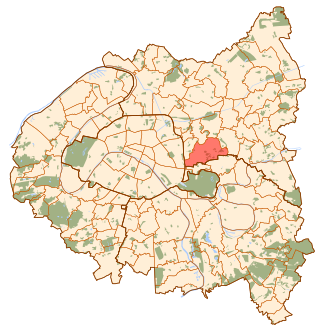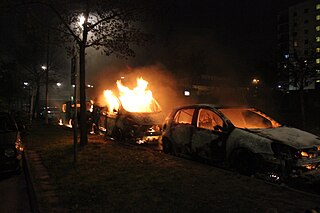Between 23 and 29 September 2006, youths of mainly immigrant descent rioted in Brussels, causing the destruction of several shop windows and the burning of ten cars and part of a hospital. The immediate cause of the riots was anger at the unexplained death in custody of a local man of Moroccan origin, Fayçal Chaaban.
A court later found 2 prison doctors guilty of assault/battery and failing to aid a person in mortal danger having administered a fatal dose of tranquilizers and gave them a 6-month suspended jail sentence.
Fayçal Chaaban, 25, had been involved in criminal activities since he was 13. He had been convicted for stealing in 2001, 2003, 2004 and 2005, and had been in prison since 16 September on the suspicion of theft. He started to serve a 10-month term in the prison of Forest, a Brussels municipality, [1] after being caught at the wheel of a vehicle with no driving license and no insurance.
Chaaban was found dead in his cell on 24 September. He died after being administered tranquilizers in his cell. An autopsy on the body failed to throw a light on the exact cause of death. According to police pathologists, the body didn't show any traces of violence. Further tests were needed to determine whether there is a link between the tranquilizers and the death, but prosecutors said the results of toxicology tests would take weeks to come back from the laboratory. [2]
Belgian Justice Minister Laurette Onkelinx visited the deceased man's family shortly after his death. [3]
The riots began in the Marolles (Marollen) quarter of Brussels and the area near the Brussels-South Railway Station on the evening of 23 September 2006. Between 1 and 4 am, ten cars were set on fire, several car and shop windows were smashed, and one shop was set alight. Violence continued each night during the next days. On 26 September, after hearing the news on the death of Fayçal Chaaban, crowds of young persons started throwing stones at passing people and cars, smashing car windows and setting them ablaze, demolishing bus shelters and looting shops. The rioters also threw molotov cocktails into CHU Saint-Pierre, which caught fire and required fire brigade intervention. During the incident, the rioters managed to steal the keys of the fire engine.
Brussels' police arrested 30 rioters on 26 September 45 rioters on 27 September and 53 rioters on 28 September.[ citation needed ] Police said some of those arrested were carrying material to make petrol bombs. [2] At least 242 crime files were opened by the police.
Most rioters were identified as immigrant youths from North-African origin, who claimed that they are upset by the death of Chaaban. A Belgian official said that the rioting was the worst since youths set fire to 15 vehicles across Belgium in November 2005, in violent riots which authorities said imitated unrest then going on in France.
On Belgian RTBF radio, Brussels's mayor Freddy Thielemans thanked the family of the late Fayçal Chaaban for helping to try to calm down the rioters.
By 29 September, the situation was said to be calm again.

The October 2000 protests, also known as October 2000 events, were a series of protests in Arab villages in northern Israel in October 2000 that turned violent, escalating into rioting by Israeli Arabs, which led to counter-rioting by Israeli Jews and clashes with the Israel Police and ending in the deaths of 13 Arab demonstrators and 1 Israeli Jew.

Football hooliganism, also known as soccer hooliganism, football rioting or soccer rioting constitutes violence and other destructive behaviours perpetrated by spectators at association football events. Football hooliganism normally involves conflict between gangs, in English known as football firms, formed to intimidate and attack supporters of other teams. Other English-language terms commonly used in connection with hooligan firms include "army", "boys", "bods", "casuals", and "crew". Certain clubs have long-standing rivalries with other clubs and hooliganism associated with matches between them is likely to be more severe.

The 2005 French riots, was a three-week period of riots in the suburbs of Paris and other French cities, in October and November 2005. These riots involved youth in violent attacks, and the burning of cars and public buildings.

The following is a timeline of the 2005 French riots that began Thursday, 27 October 2005. Where the source lists events as occurring in a night and following morning, this article lists them on the date of the night, not the following morning. The extent table in the main article does the opposite.

The 2005 French riots led to a domestic and international response.

Black July was an anti-Tamil pogrom that occurred in Sri Lanka during July 1983. The pogrom was premeditated, and was finally triggered by a deadly ambush on 23 July 1983, which caused the death of 13 Sri Lanka Army soldiers, by the Tamil militant group Liberation Tigers of Tamil Eelam (LTTE). Although initially orchestrated by members of the ruling UNP, the pogrom soon escalated into mass violence with significant public participation.
In November and December 2006, the desecration of an Ambedkar statue in Kanpur triggered off violent protests by Dalits in Maharashtra, India.
Riots in the Val-d'Oise department in France began 26 November 2007, following the deaths of two teenagers, whose motorcycle collided with a police vehicle. The circumstances recalled those that precipitated the 2005 unrest, which began in Clichy-sous-Bois when two teenagers lost their lives as they evaded arrest while hiding in an electrical substation.

The Marolles or Marollen is a popular historic neighbourhood of downtown Brussels, Belgium, situated between the Palace of Justice to its south-east, the Chapel Church to its north and the Halle Gate to its south. Its inhabitants are called Marolliens.

The 2008 Greek riots started on 6 December 2008, when Alexandros Grigoropoulos, a 15-year-old Greek student, was killed by a special officer in Exarcheia district of central Athens. The killing of the young student by police resulted in large protests and demonstrations, which escalated to widespread rioting, with numerous rioters damaging property and engaging riot police with Molotov cocktails, stones and other objects. Demonstrations and rioting soon spread to several other cities, including Thessaloniki, the country's second-largest city, and international cities in solidarity. Newspaper Kathimerini called the rioting "the worst Greece has seen since the restoration of democracy in 1974".

On 29 December 2008, violent riots first broke out in Oslo, Norway amid protests against the Gaza War, starting outside the Israeli embassy. Riots broke out again following a protest on 4 January 2009, while the most violent and destructive riots took place on 8 and 10 January when riots spread throughout the city with widespread destruction of private and public property, clashes between rioters and police with several injuries, as well as attacks on civilians, including individuals targeted due to being thought by rioters to be Jews. Around 200 people were arrested in total, mainly Muslim youth, supported by left-wing autonomous Blitz activists.

A series of riots took place in July 2009 in France. On Bastille Day in the commune of Montreuil, an eastern suburb area of Paris, French youths set fire to 317 cars. Thirteen police officers were injured. On July 9, many youths started a protest in Firminy near Saint-Étienne, after the death of a young Algerian man, Mohamed Benmouna, in police custody. Benmouna's parents rejected the official account of suicide. Riots on Bastille day are a frequent occurrence in France as the disaffected protest high unemployment rates and failed integration policies for minorities. More than 240 people had been arrested near Paris.

In early August 2011, England was struck by riots, the worst in the country in decades. The timeline of the events of the riots spanned from 6–10 August.
Aboud Rogo Mohammed was a Kenyan Muslim cleric. He was alleged to have been an Islamist extremist and was accused of arranging funding for the al-Shabaab militia in Somalia. He was shot dead in Kenya, and his death triggered protests and violence by hundreds of protestors. Rogo is the fifth alleged Islamic radical killed in Kenya in 2012. David Ochami, a Kenyan journalist, stated that Rogo had the oratory prowess of Hezbollah leader Hassan Nasrallah and the logic of Egyptian ideologue Yusuf al Qaradawi.

On 19 May 2013, violent disturbances broke out in Husby, a suburb dominated by immigrants and second-generation immigrant residents, including a substantial number from Somalia, Eritrea, Afghanistan and Iraq, in northern Stockholm, Sweden. The riots were reportedly in response to the shooting to death by police of an elderly man, reportedly a Portuguese expatriate, armed with a puukko knife, after entering his apartment and then allegedly trying to cover up the man's death.

The Brussels ISIL terror cell were a group accused of involvement in large-scale terrorist attacks in Paris in November 2015 and Brussels in early 2016, as well as other attacks against European targets. The terror cell is connected to the Islamic State of Iraq and the Levant (ISIL), a jihadist terrorist organisation primarily based in Syria and Iraq.
The 2016 Coimbatore riots refers to the riots that took place in Coimbatore from September 22 to September 24, 2016, by members of the Hindu Munnani after the murder of the outfit's district spokesperson, C Sasikumar.
The 1967 Toledo riot was one of 159 race riots that swept cities in the United States during the "Long Hot Summer of 1967".
A series of riots in loyalist areas of Northern Ireland began in Waterside, Derry, on 30 March 2021. After four nights of rioting in Derry, disturbances spread to south Belfast on 2 April, where a loyalist protest developed into a riot involving iron bars, bricks, masonry and petrol bombs. Following this, civil unrest spread to Newtownabbey on 3 April, where cars were hijacked and burnt, and petrol bombs were also used against police. Carrickfergus in southern County Antrim also saw serious civil unrest on the night of 4 April and morning of 5 April, where loyalists created roadblocks to keep police out of local estates and threw petrol bombs at police vehicles.